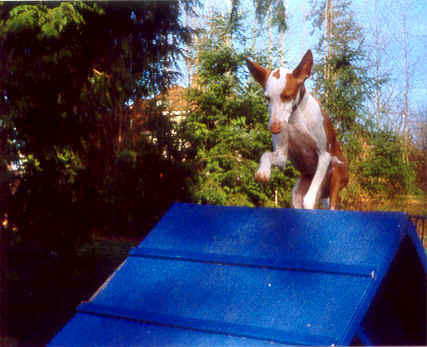|
|
|
 |
Some Thoughts on TrainingIbizan Hounds |
The history of formal obedience and training began with Schutzhund and military training. These well-crafted programs produced excellence when used with a traditional obedience breed, a working, sporting, or herding breed of dog such as a Doberman Pinscher, Golden Retriever, or Corgi. Competition Obedience, as developed for the AKC, was to highlight the abilities of Poodles and German Shepherds, and applying the training techniques that work so well in the military produced impressive performances. Today many refer to this traditional type of training as the jerk-and-pull method, as it is based on verbal reward and physical correction (n.b., not punishment).
Using the traditional training techniques on hounds did not yield the same results, and hounds were labeled difficult to train. Then in 1980 Playtraining Your Dog by Patricia Gail Burnham appeared, and revolutionized the training scene. Using her Greyhounds as living examples, the author advocated training as a game, stimulating the dog's sense of play. Since then, trainers such as Terri Arnold and AnneMarie Silverton have elaborated on this concept, and many handlers have achieved extraordinary success with their hound breeds.
Even earlier, clicker training was being formalized and developed, and Karen Pryor popularized this training philosophy. Now many excellent books, videos, and Internet sites explain and assist handlers who juggle food and a clicker around a suddenly enthusiastic hound.
The Ibizan Hound has never been bred to work closely with his human counterpart. It simply is not his nature, and the wise handler respects this. Physical manipulation, correction, and repetition are distressing to Ibizans, and their willingness to train will quickly fade if these methods are used to communicate with the dog. While it is entirely possible to achieve the same end result---high scores and qualifications---as with traditional breeds, training toward this end is best done using nontraditional methods. Play---which seems to be closely related to prey drive, food, and pack drive, wisely used, can produce an enthusiastic, eager canine teammate.
|
Conditioning for Canine Sports |
Exercise is one of the most neglected tools for training the dog, whether it is training for basic manners or for a sport. Exercise decreases the chance of sports injury, decreases the severity of injury, and lessens the chance of obesity, the leading cause of morbidity in dogs in the United States. Lack of exercise is regarded as the primary cause of behavioral problems.
Training for a specific canine sport is skill-training---the acquisition of specific skills---and is not a substitute for strength or endurance training.
Strength training begins the day the puppy comes home, and includes such activities as free play, walks, retrieving, and short swims. Skill and strength training can be combined in teaching the young dog various exercises such as crawling through tunnels, backing up, sitting up on his haunches, and jumping low obstacles.
Endurance-building activities consist of a minimum of ten minutes of running, jogging (faster than a slow trot), or swimming in a repetitive, nonstop motion. Only when the growth plates have closed on the young dog should he be exposed to an endurance training program. In Ibizan Hounds this is at about two years of age. The older dog should begin a program with five minutes of nonstop activity, and work up in increments until reaching a maintenance schedule of 20 minutes of non-stop exercise three times a week. The wise owner will participate in the activity as well, rather than road-work from a car or use a treadmill. Dogs are more heat-sensitive than humans are, and by engaging in the activity with your dog, you are aware of how much heat your dog is exposed to, and can detect any impending problems more easily.
For detailed information on designing a training program for your dog, Peak Performance: Coaching the Canine Athlete by Chris Zink, DVM, PhD. is an excellent resource.
 |
 |
Assessing Lameness: This article describes the useful tests and guides you can use to assess lameness in any breed of dog. This is based on Dr. Zink's lecture-demonstration, and is printed with her permission. Dr. Zink is the author of Peak Performance: Coaching the Canine Athlete and Jumping from A to Z. |
| On June 17 2000 Tien Tran took photographs of the author's Ibizan at a Seattle agility trial. |
Internet Resources: |
| Lure Coursing:
|
| Agility
|
| Conformation
|
| Obedience
|
| Tracking
|
| Overview
|
| Sports Conditioning
|
Home |
Introduction |
Breed Standards |
Living With an Ibizan Hound |
What's So Special |
Canine Sports |
Breeders' Ethics |
Find a Good Breeder |